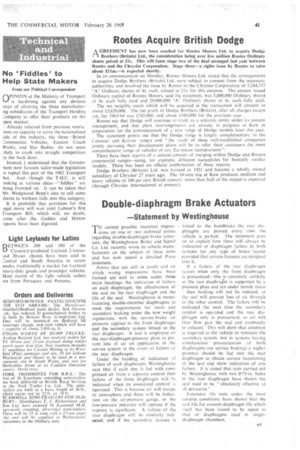Double-diaphragm Brake Actuators
Page 43

If you've noticed an error in this article please click here to report it so we can fix it.
—Statement by Westinghouse
TO correct possible incorrect impressions on one or two technical points regarding double-diaphragm brake actuators, the Westinghouse Brake and Signal -Co. Ltd. recently wrote to vehicle manufacturers on the subject of these units and has now issued a detailed Press statement.
Points that are still in -doubt and on which wrong impressions have been formed are said to come under three main headings: the indication of failure on each diaphragm, the effectiveness of the seal on the rear diaphragm and the life of the seal. Westinghouse is manufacturing double-chamber diaphragms to meet the requirements for main and secondary braking under the new weight regulations, with the service-brake air pressure applied to the front diaphragm and the secondary system linked to the rear diaphragm. A seal is employed on the rear-diaphragm-pressure plate to prevent loss of air on application of the service system in the event of failure of the rear diaphragm.
Under the heading of indication of failure of each diaphragm. Westinghouse says that if each one is fed with compressed air from a separate control then failure of the front diaphragm will be indicated when its associated control h operated. This is because air will escape to atmosphere and there will be indication on the air-pressure gauge, or the low-pressure indicator will operate if the rupture is significant. A failure of the rear diaphragm will be similarly indicated,. and if the secondary feature is
linked to the handbrake the rear (haphragms are proved every time the vehicle is parked. The statement goes on to explain how there will always be. indication of diaphragm failure in both systems for any type of brake layout provided that certain features are designed into it.
If a failure of the rear diaphragm occurs when only the front diaphragm is pressurized—this is extremely unlikely as the rear diaphragm is supported by a , pressure plate and not under tensile stress --then braking will not be reduced, as, the seal will prevent loss of air through. to the other control. The failure will be indicated the next time the secondary control is operated and the rear diaphragm only is pressurized, as air will then flow past the seal and eventually' To exhaust. This will show that attention is required to the vehicle to reinstate the secondary system, but in systems having simultaneous pressurization of both diaphragms (on service braking) a higher pressure should be fed into the rear diaphragm to obtain correct functioning . of the seal and show indication of any failure, it is stated that tests carried out by Westinghouse with two 0-75-in, holes in the rear diaphragm have shown the seal used to be " absolutely effective at all pressures."
Extensive life tests under the most adverse conditions have shown that he seal life far exceeds diaphragm life which . itself has been found to be equal to that of diaphragms used in single' diaphragm chambers.




















































































































